Memories of MAPS (M.A. Partha Sarathy)
First published in Sanctuary Asia,
Vol. 43
No. 8,
August 2023
By Vance G. Martin
The conference room in Montreal was full. It was the mid 1980s, and most of the participants were members of the International Union for Conservation of Nature (IUCN). As President of WILD Foundation, a non-profit organisation working to save Earth’s life-saving wilderness, I had registered WILD as a member of the IUCN and was focused on a strategy that would make it the first global institution to recognise ‘wilderness’ as an official, distinct category of natural, Protected Areas. It was an uphill battle, even within the conservation world – but we eventually succeeded in 1992. At the point I was in that conference room in Montreal, we had already worked for 10 years through our World Wilderness Congress (WWC) to move this process forward. I was in Canada to continue pushing that stone up the hill as we planned the fourth WWC for Denver in 1987. The World Wilderness Congress is the longest-running, public environmental forum to build awareness and support for wilderness, and strengthen wilderness policy from grassroots decision-making to national policy. It combines culture with science, policy and economics and enables collaboration between communities and world leaders to build a collaborative global wilderness community.
_1691485989.png)
MAPS and Vance G. Martin with a jury member of the Global Environmental Film Festival. His appreciation for making movies made him evangelise the importance of film festivals dedicated to wildlife. Photo: Vance Martin
Meeting Partha
During that meeting I noticed a distinguished man, past middle age yet youthful, possibly of South Asian descent. Slight of build but with a radiant energy, he walked purposefully through the main conference room, scanning the aisles with laser-like intensity, obviously searching for someone specific. At the coffee break I saw him again, having captured his target, and now in deep discussion in a corner.
Though a young man and a somewhat new face in the formal global conservation sector, I was on a mission and needed to enlist others with energy and enthusiasm to our wilderness cause. It was no time for me to be a wallflower. I had been in and out of South Asia, particularly India numerous times starting in the early 70s, I loved the region and its cultures, and I wanted to meet this man. So, as soon as protocol allowed, I stepped forward and introduced myself. He smiled and looked at me, extended his hand and said, “I’m Partha Sarathy. Just call me Partha!” So began a friendship and conservation collaboration that endured until he passed away in 2013.
In Montreal, Partha and I huddled together. He wanted to know exactly what I was up to. We quickly discovered a characteristic we had in common that was uncommon among our colleagues, mostly all of whom were talented, science and policydriven conservationists – we both understood and worked in ways that celebrated and insisted upon culture being an equal partner in conservation, along with science, economics and policy. We both held firmly to the knowledge that this was essential if solutions to the growing environmental crisis would endure, and that it was possible and necessary at every scale, from local to global. He quickly and eagerly agreed to be involved with the fourth WWC. Two years later he came to Denver as a featured presenter among 1,800 delegates from over 60 countries, including Prime Minister Brundtland of Norway (of Brundtland Report fame), and some 17 assorted ministers of Environment, State and Finance. We accomplished many practical achievements at that Congress, such as starting the process that led to the creation of the World Bank’s Global Environmental Facility (which has since become the world’s largest funder of biodiversity conservation); producing the first global inventory of remaining wilderness (done by Mike McCloskey, Chairman of the Sierra Club, and his team using large paper jet navigation maps, rulers and slide rules – pre-digital, of course, imagine that!); and much more.
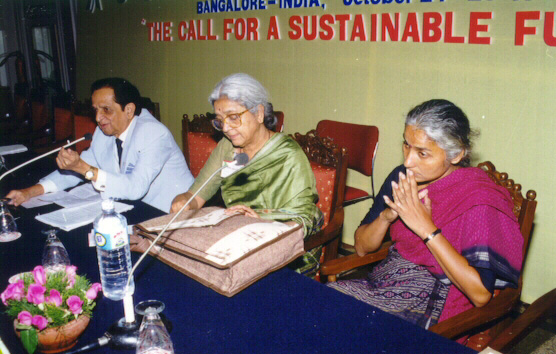
MAPS chairs a panel on the importance and possibilities of collaboration between human rights and conservation that featured activist Medha Patkar (right) at the sixth World Wilderness Congress (1998), the very first to be conducted in India, in Bengaluru. Photo: Vance Martin
One of my clearest and most precious experiences of that Congress, however, was meeting M. A. Partha Sarathy – MAPS, as he was often called, again. He came up to the main platform and first presented me with a garland of fresh flowers, and spoke of the tradition of nature worship in India. He then introduced the special guest he had brought from India, the great classical Indian dance master, Dhananjayan, who then performed a traditional Kathakali dance before the assembled delegates, the first time that anything such as this had occurred during the plenary of a global conservation gathering.
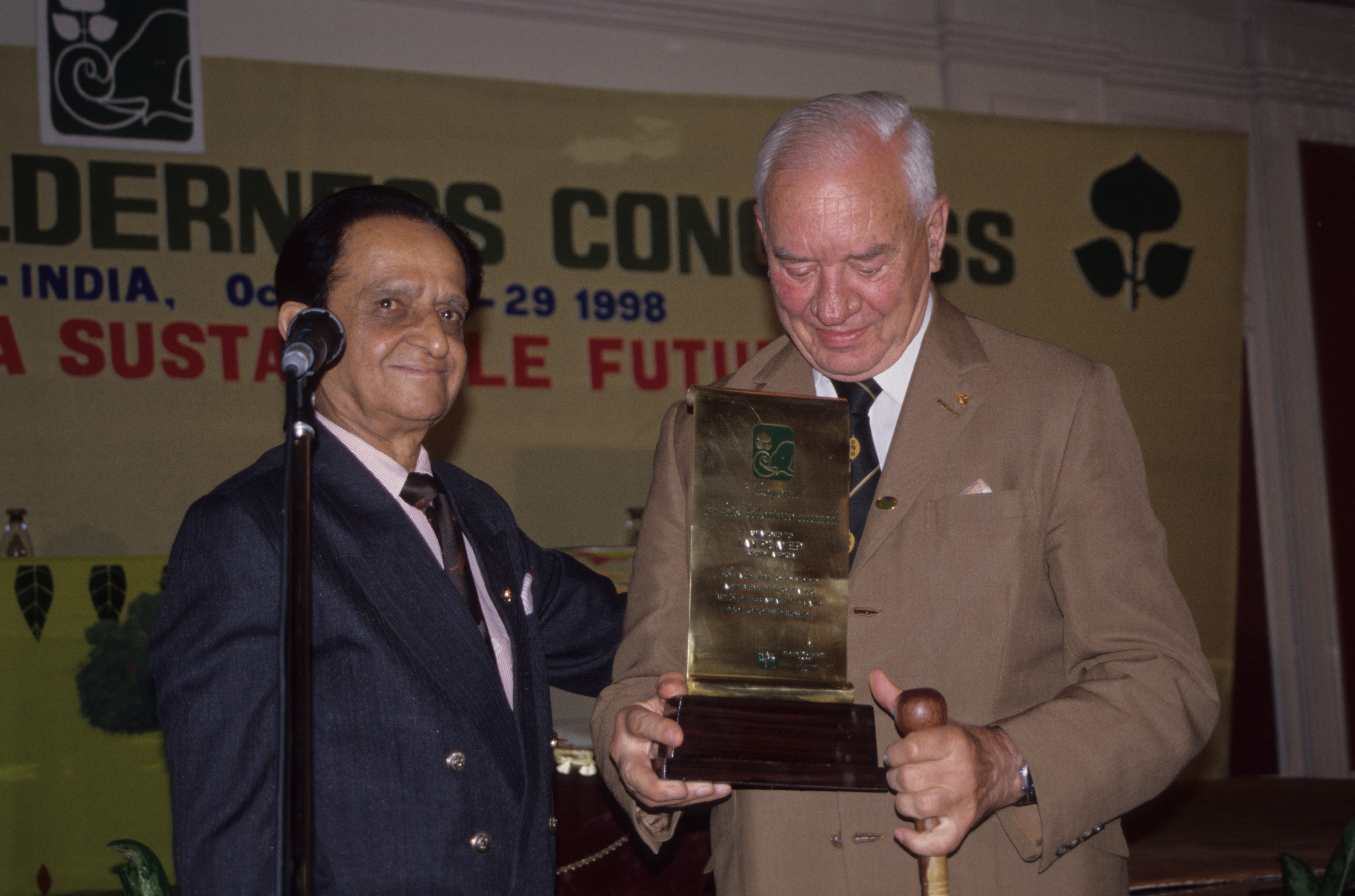
MAPS presents a Global Wilderness Hero award to Dr. Ian Player at the sixth WWC, founder of the World Wilderness Congress. Photo: Mimi Partha Sarathy.
A Man of Action
MAPS contributed significantly to the IUCN. He was Chairman for many years of what was called the IUCN Education Commission. In that role, he was the spark plug in igniting the drive towards an appropriate change in the name to Commission on Education and Communications, exhibiting a cutting-edge awareness of the rapidly-increasing importance of media and communications as a key tool for public environmental awareness.
Partha served on the board of directors of the WILD Foundation for many years. It was at the fifth WWC (Norway, 1993) that he pulled me into a corner and said, “I noticed on your global map of the WWC locations there was a blank spot in Asia.” With a distinct gleam in his eye he then said to me, “We need to fix that. I’m in for 6WWC in India!” And he was, and therefore it convened in his hometown of Bangalore (now Bengaluru) in 1998. He also organised the Global Environmental Film Festival and Awards at that sixth Congress, and continued doing the Festivals and Awards at the seventh WWC (South Africa, 2001) and eighth WWC (Alaska, 2005). So, the story continued.
My memories of MAPS are many, as a bright light and a driven conservationist, a successful businessman, and a cultural maven who was at once as urbane and globally charming as he could be childlike. On that important quality of innocence and child-like enthusiasm, I finish with one final story. In the late 1980s, Partha brought his wife and two young children to the States, on one stop of which they visited with my young family in Fort Collins, Colorado. I toured them around the Rocky Mountain National Park and elsewhere. On the quest to give them a quintessentially American, pop-culture experience, I took our combined four young children and four adults to ‘Chuckee-Cheese’, a kitschy and splashy pizza restaurant nestled within a gigantic children’s playground of huge electronic, moving and talking animals, and other games. One of the games was a large pit of plastic balls in which the children could play. Without a second thought, MAPS grinned widely and dove into the pit of yellow plastic balls as if it were a swimming pool, and started freestyle swimming with balls flying everywhere, all the while laughing uncontrollably. One of his two young children on that trip was Mimi Partha Sarathy (see box), now a force in her own right who combines a love of nature, a commitment to culture and spirit, and a professional financial acumen. The apple doesn’t fall far from the tree.
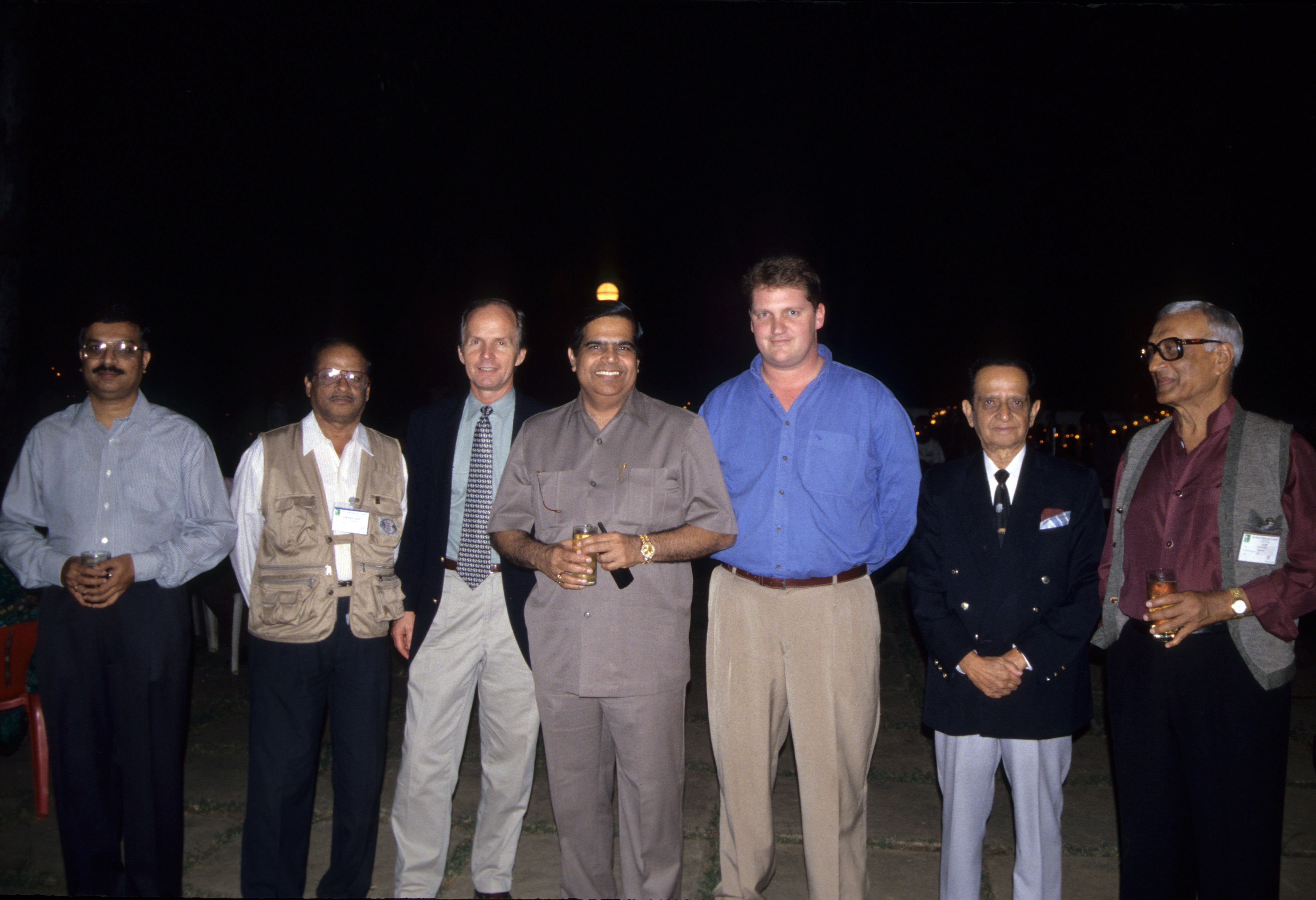
MAPS, Andrew Muir (CEO, Wilderness Africa; on his immediate right) and Vance G. Martin (President, WILD; third from left) with delegates from India, Sri Lanka and Pakistan at the sixth WWC. Photo: Vance Martin.
My ‘Wild and Wonderful’ Father
By Mimi Partha Sarathy
Be fearless and dream big – these are the two most important things I surely learnt from my father. ‘Partha’, as he was fondly known among friends and colleagues, was way ahead of his time on many subjects – be it conservation, wildlife, urban planning and development, or women empowerment.
My Appa – M. A. Partha Sarathy – and I had a special bond. We both loved the movies and cried when they touched us. His appreciation for making movies is what made him evangelise the importance of film festivals dedicated to wildlife as what would make people truly understand and connect to the wonder of nature... We loved going out to eat, and our all-time favourite was travel.
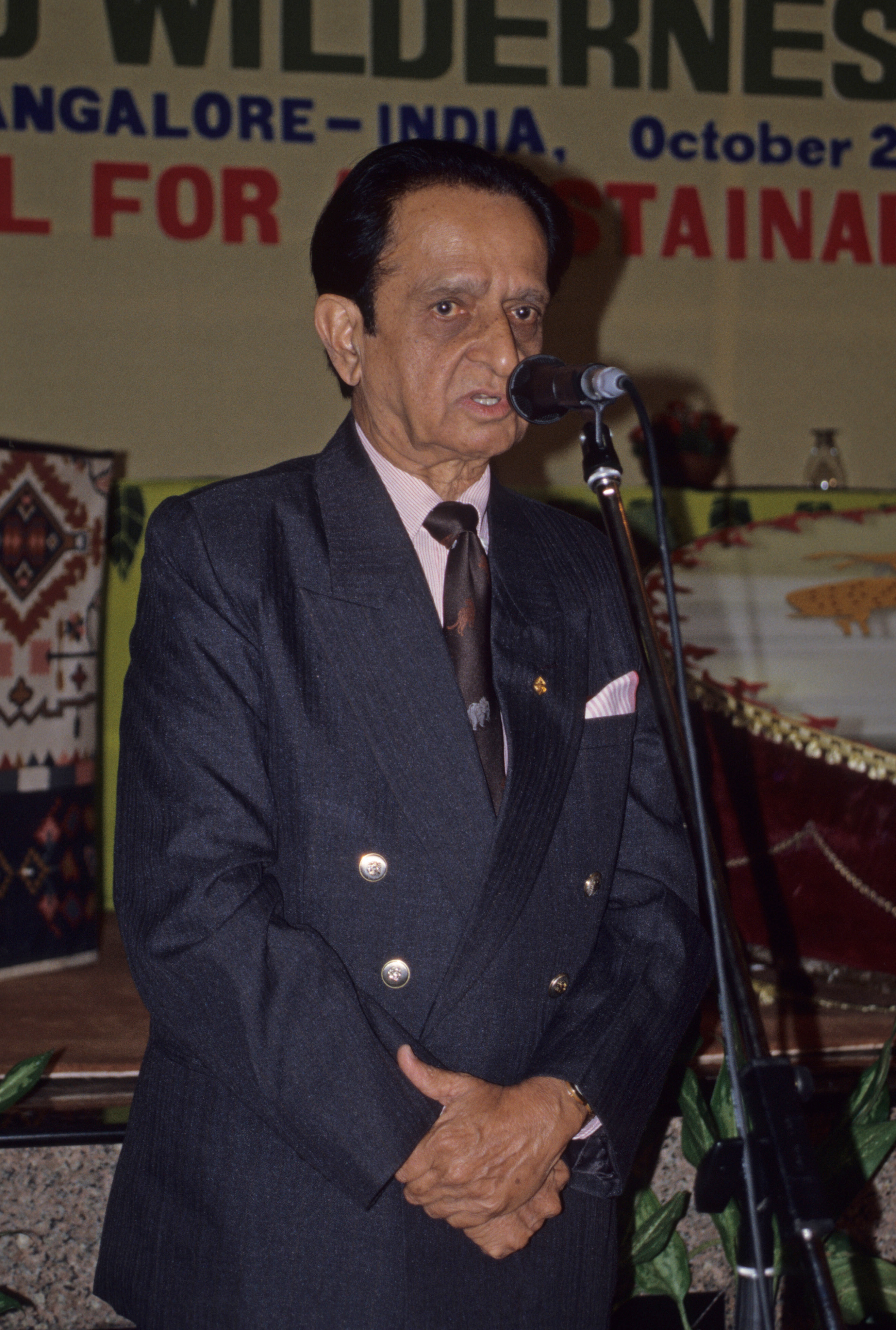 MAPS was instrumental in making many young people aware about wildlife conservation through the work he did in India and around the world. Photo: Mimi Partha Sarathy.
MAPS was instrumental in making many young people aware about wildlife conservation through the work he did in India and around the world. Photo: Mimi Partha Sarathy.
Since my teenage years, I have always referred to myself as my father’s ‘excess baggage’, as I joined him all over the world during his many trips. From IUCN conferences to wildlife film festivals, I was blessed to be part of such events, and meet so many interesting people – many of whom I still know today and experience something truly special. I have travelled in the ‘wild’ with him in many parts of USA, Africa and Europe, and each trip was a one-ofits- kind experience. We spent some of the best times together when I studied in Geneva, in the early 1990s, when he was Chairman of IUCN’s Education Commission in Gland, Switzerland. Our last trip overseas was to Japan in 2004. Not surprisingly, this travel bug is still very much in me.
Appa’s compassion and obsession with wildlife and for conservation was truly remarkable. Being amidst nature and experiencing wildlife anywhere in the world is something that he lived for, and he wanted everyone to experience this amazing feeling. He was instrumental in making many young people aware about wildlife conservation through the work he did in India and around the world, to the extent that even today people remember him for this.
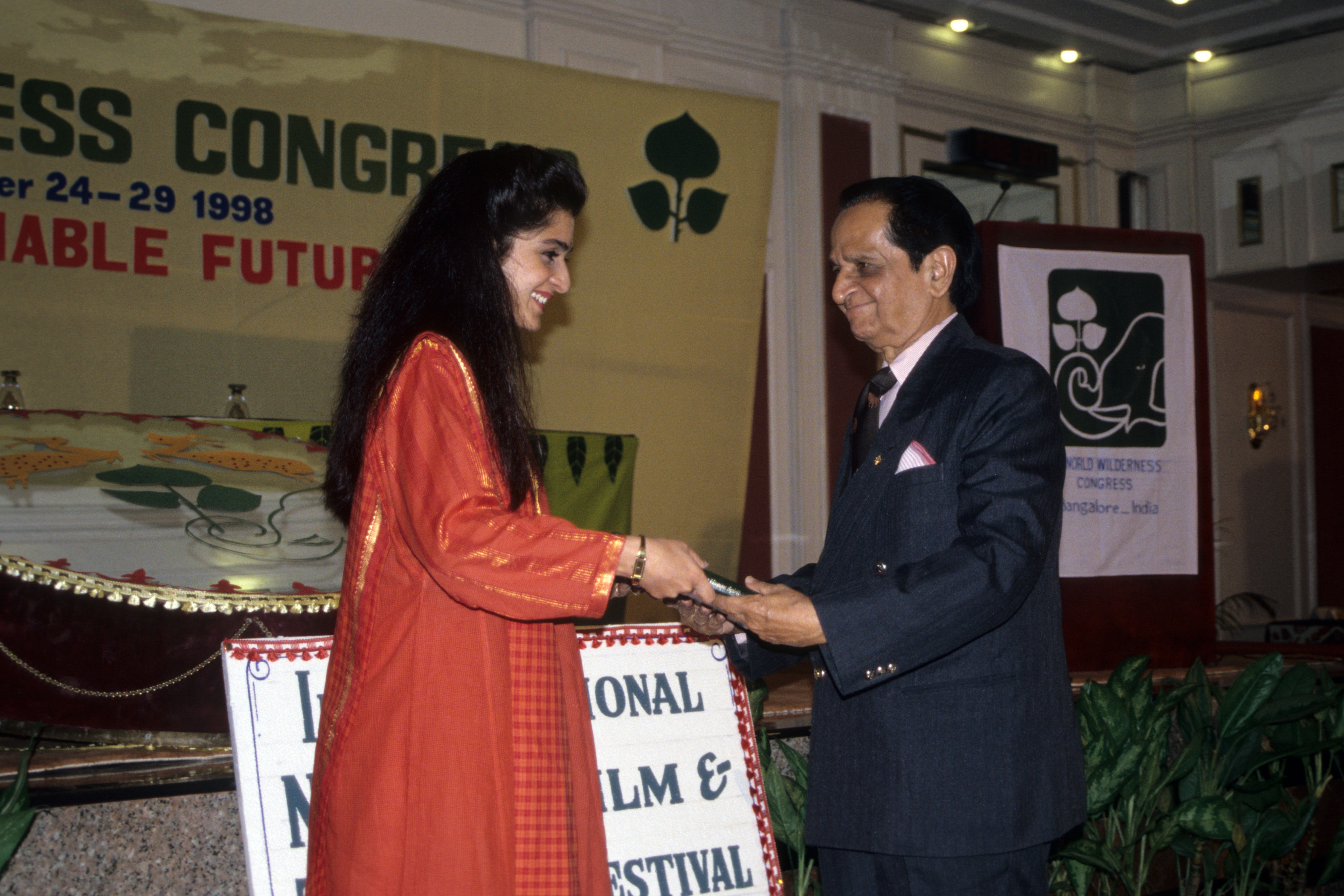 Mimi Partha Sarathy helps her father MAPS present awards to the winners of the Global Environmental Film Festival. She joined him all over the world during his many trips, from IUCN conferences to the wilds of Africa, Europe and USA. Photo: Mimi Partha Sarathy.
Mimi Partha Sarathy helps her father MAPS present awards to the winners of the Global Environmental Film Festival. She joined him all over the world during his many trips, from IUCN conferences to the wilds of Africa, Europe and USA. Photo: Mimi Partha Sarathy.
Integrating science with traditional knowledge and techniques for sustainable conservation efforts was important for my father. Understanding, preserving and protecting sacred forests, and blending ancient wisdom and science across cultures and continents were close to his heart. It is so uncanny that my daughter Hamsini, who is 29 years old and now lives in Broome, Australia, has inherited my father’s vision and passion for wildlife and conservation, and is a leading ecologist and land management scientist with the NGO Environs Kimberly, working with Aboriginals/Indigenous people in Western Australia on projects related to environment and climate change. I call her my ‘Mowgli’ as she is truly walking the talk in this very harsh and remote land. I am so blessed to see the next generation be equally committed and dedicated to our planet.
My father saw divinity and spirituality in nature, which touched him greatly. This can be seen in the many wonderful books and short stories he has written, including Brahma, One Way to Benares, Live a Little and Monkey Girl. Of course, the magnificent Asian elephant was his all-time favourite!
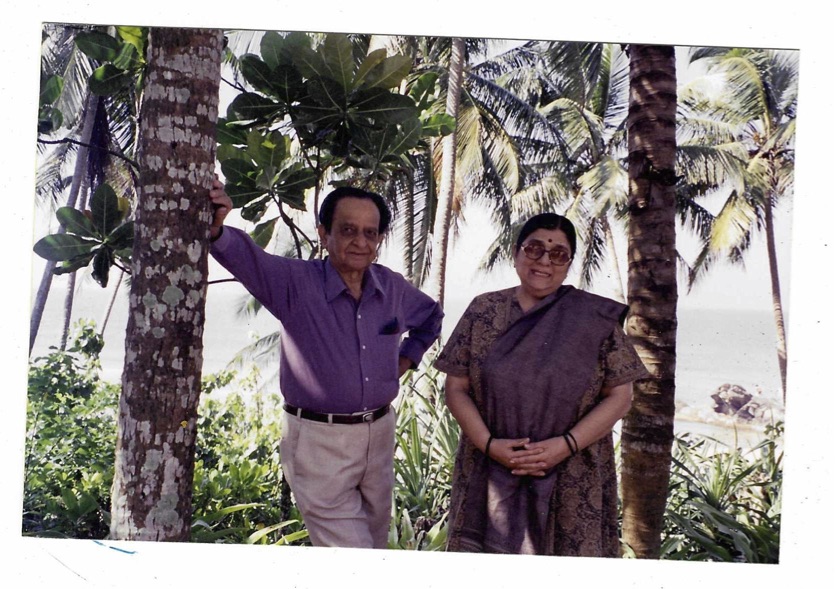 MAPS and his wife Vedavalli, now 88, on one of their many trips. Photo: Mimi Partha Sarathy.
MAPS and his wife Vedavalli, now 88, on one of their many trips. Photo: Mimi Partha Sarathy.
Appa was one of the best communicators I have ever known. He would speak to anyone and everyone he met, building an instant rapport. Often when I was younger it was a bit annoying, but we all realise how important the power of communication is today. Everywhere he went he carried his Sony camera, taking videos, making small films to share with others, about wildlife, conservation, or urban planning. He understood the power of visual representation as crucial for sharing knowledge and teaching people the importance of these subjects. Today, with our cell phones being the greatest tool, we have it much easier. It has been more than 10 years since my dad has passed away and believe me, he would have loved to be alive today, and would have rocked even more. I am filled with gratitude every day for my parents who have made me the person I am, and for my daughter Hamsini, who has inherited her grandfather’s passion for conservation and nature. Blessed indeed.
Vance G. Martin created and built-out the WILD Foundation and its mission for wilderness, wildlife and people, serving for 40 years as its President and also the Global Director of the World Wilderness Congress. He now continues his work as President (Emeritus) of Wilderness Foundation Global, an international alliance born-and-based in the Global South.
Mimi Partha Sarathy is the Founder Managing Director of Sinhasi Consultants Pvt. Ltd. and Founder Director of Sri Krishna Wellness Yoga Centre.

.png)
_1691485989.png)





